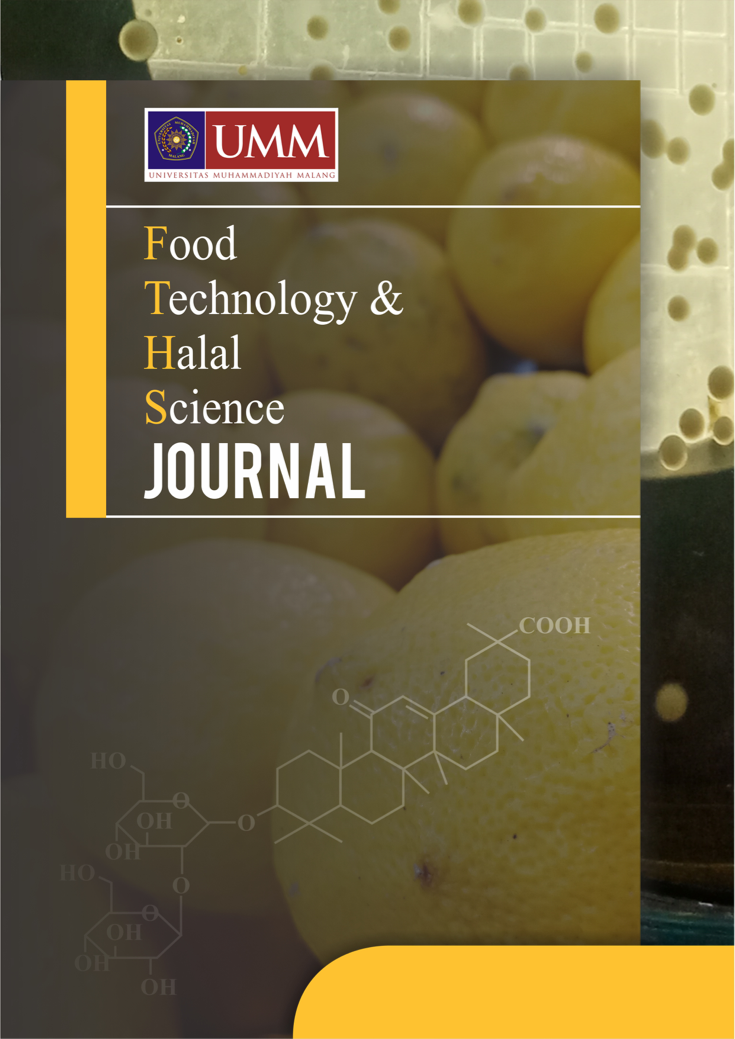Daya Terima, Zat Gizi, dan Nilai Energi Roti Tawar Anti- Diabetes dengan Penambahan Sari Mengkudu (Morinda citrifolia L.)
DOI:
https://doi.org/10.22219/fths.v3i1.13060Keywords:
calorie changes, noni juice, sensory enhancements, white bread formulationsAbstract
White bread is a popular food product in Indonesia which is dominated by carbohydrate content. To improve its function, the noni juice which has phytochemical compounds of the alkaloid group was added. However, noni has a very strong aroma, which makes this noni rarely processed. This study aims to analyze the nutritional content, energy value, and organoleptic test of white bread added with noni juice. This research used a descriptive experimental design that the data is compared with SNI No 01-3840-1995 of white bread (Standard Nasional Indonesia = Indonesia Standard Requirement). Noni juice is added by four levels (0, 50, 150, 250ml). The results found that the more noni juice added would cause the addition of flour used, thereby increasing the calories per serving. In addition, the addition of noni juice causes an increase in brown color and aroma but decreases the tenderness, and sweetness of white bread.
Downloads
References
Almatsier, S. 2004. Prinsip Dasar Ilmu Gizi. Gramedia Pustaka Utama. Jakarta
Andarwulan, N., Kusnandar, F., Herawati, D. 2011 .Analisis Pangan. Jakarta:
Dian Rakyat.
AOAC. 2005. Official Method of Analysis of the Association of Official Analitycal
Chemist. 18th ed. Maryland: AOAC International. William Harwitz (ed).
United States of America.
Baequny, A., Afiyah, S.H., Elsye, R. 2015. Pengaruh Pola Makan Tinggi Kalori
terhadap Peningkatan Kadar Gula Darah pada Penderita Diabetes Mellitus
Tipe 2. Jurnal Riset Kesehatan Vol. 4 No. 1
BPOM (Badan Pengawas Obat dan Makanan). 2005. Pedoman Pencantuman
Informasi Nilai Gizi Pada Label Pangan. Direktorat Standarisasi Produk
Pangan. Deputi Bidang Pengawasan Keamanan Pangan dan Bahan
Berbahaya. Badan Pengawas Obat dan Makanan. Republik Indonesia
M.A.J.S. van Boekel. 2006. Formation of flavour compounds in the Maillard
reaction. Biotechnology Advances . 24, 230– 233
David, O., Eric, A., Samuel, O.K., Eric, B., Patrick, S. 2015. Proximate
Composition and Some Functional Properties of Soft Wheat Flour.
International Journal of Innovative Research in Science, Engineering and
Technology. Vol. 4, Issue 2, 753-758
Dudusola,I.O. 2010. Comparative evaluation of internal and external qualities of
eggs from quail and guinea fowl. Int. Res. J. Plant Sci. 1: 112-115.
Gandama, Petrus. 2012. Pola Konsumsi Roti. BINUS, Jakarta
Horbanczuk, J.O. 2002.The Ostrich. European Ostrich Group, Ribe, Denmark
Laelatunisa, N., Nikmatul, R., Rachmadanti, A., Rista, A. 2019. Efek
Penambahan Sari Buah Mengkudu (Morinda citrifolia L.) pada Roti Tawar
terhadap Kadar Glukosa Darah Pada Tikus yang Diinduksi Aloksan. Jurnal
Food Technology and Halal Science Vol 2 No 2 : 282-290
Legowo, A. M., Nurwantoro, dan Sutaryo. 2005 Analisis Pangan. Badan Penerbit
Universitas Diponegoro, Semarang
Lestari, C.A., Tantan, W., dan Hasnelly. 2016. Pengaruh Substitusi Tepung
Kacang Koro Pedang (Canavalia ensiformis) Terhadap Karakteristik Roti
Tawar. Jurnal Penelitian Tugas Akhir
Mudjayanto, E. S. dan Yulianti, L.N. 2004. Membuat Aneka Roti. Jakarta:
Penebar Swadaya
Nur’Aini, A. 2011. Aplikasi Millet (Pennisetum spp) Merah Dan Millet Kuning
Sebagai Substitusi Terigu Dalam Pembuatan Roti Tawar: Evaluasi Sifat
Sensoris Dan Fisikokimia. Fakultas Pertanian Universitas Sebelas Maret.
Surakarta.
Purlis E. 2010. Browning development in bakery products – A review. Journal of
Food Engeneering, No. 99, p. 239–249.
Roessalina W, Y. 2007. Substitusi Tepung Gandum (Triticum aestivum) dengan
Tepung Garut (Maranta arundinaceae L) Pada Pembuatan Roti Tawar.
Universitas Gadjah Mada. Yogyakarta.
Sabovics, M. Evita, S, and Ruta, G. 2014.The Influence of Baking Temperature
on The Quality of Triticale Bread. Foodbalt
Sitohang, K. A. K., Z. Lubis dan L. M. Lubis. 2015. Pengaruh perbandingan
jumlah tepung terigu dan tepung sukun dengan jenis penstabil terhadap
mutu cookies sukun. Jurnal Rekayasa Pangan dan Pertanian. 3 (3): 308-315.
Standar Nasional Indonesia (SNI).01-3840-1995. Syarat Mutu Roti Tawar.
Dewan Standar Nasional. Jakarta.
Stone, H dan Joel, L. 2004. Sensory Evaluation Practices, Edisi Ketiga. Elsevier
Academic Press, California, USA
Sudarmadji, S., B. Haryono, Suhardi, 1997. Prosedur Analisa untuk Bahan
Makanan dan Pertanian. Liberty, Yogyakarta.
Sudarno. 2015. Eksperimen Pembuatan Roti Tawar Substitusi Tepung Kulit Ari
Kedelai Varietas Us. No.1. Skripsi. Jurusan Pendidikan Kesejahteraan
Keluarga. Fakultas Teknik. Universitas Negeri Semarang
Sugiharto, R., Dyah, K., dan Tias, A. 2016. Efek Penambahan Antioksidan
Terhadap Sifat Sensori dan Lama Simpan Roti Tawar yang Difortifikasi
Dengan Minyak Ikan. Jurnal Teknologi Industri & Hasil Pertanian Vol. 21
No.2
Winarno, F.G. 2002. Kimia Pangan dan Gizi. Gramedia Pustaka Utama.Jakarta
Downloads
Published
How to Cite
Issue
Section
License
Authors who publish with this journal agree to the following terms:
- Authors retain copyright and grant the journal right of first publication with the work simultaneously licensed under a Creative Commons Attribution License that allows others to share the work with an acknowledgement of the work's authorship and initial publication in this journal.
- Authors are able to enter into separate, additional contractual arrangements for the non-exclusive distribution of the journal's published version of the work (e.g., post it to an institutional repository or publish it in a book), with an acknowledgement of its initial publication in this journal.
- Authors are permitted and encouraged to post their work online (e.g., in institutional repositories or on their website) prior to and during the submission process, as it can lead to productive exchanges, as well as earlier and greater citation of published work (See The Effect of Open Access).










